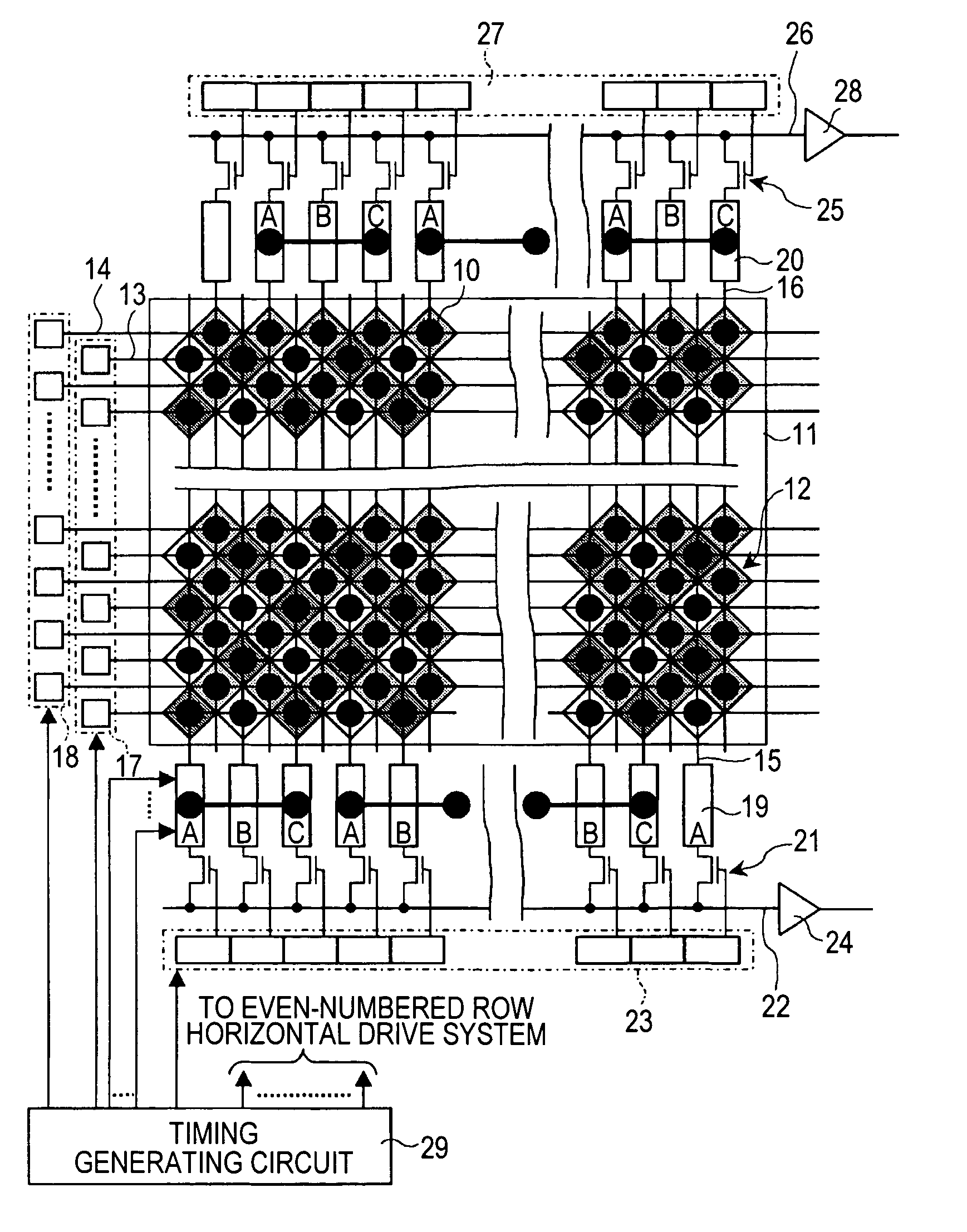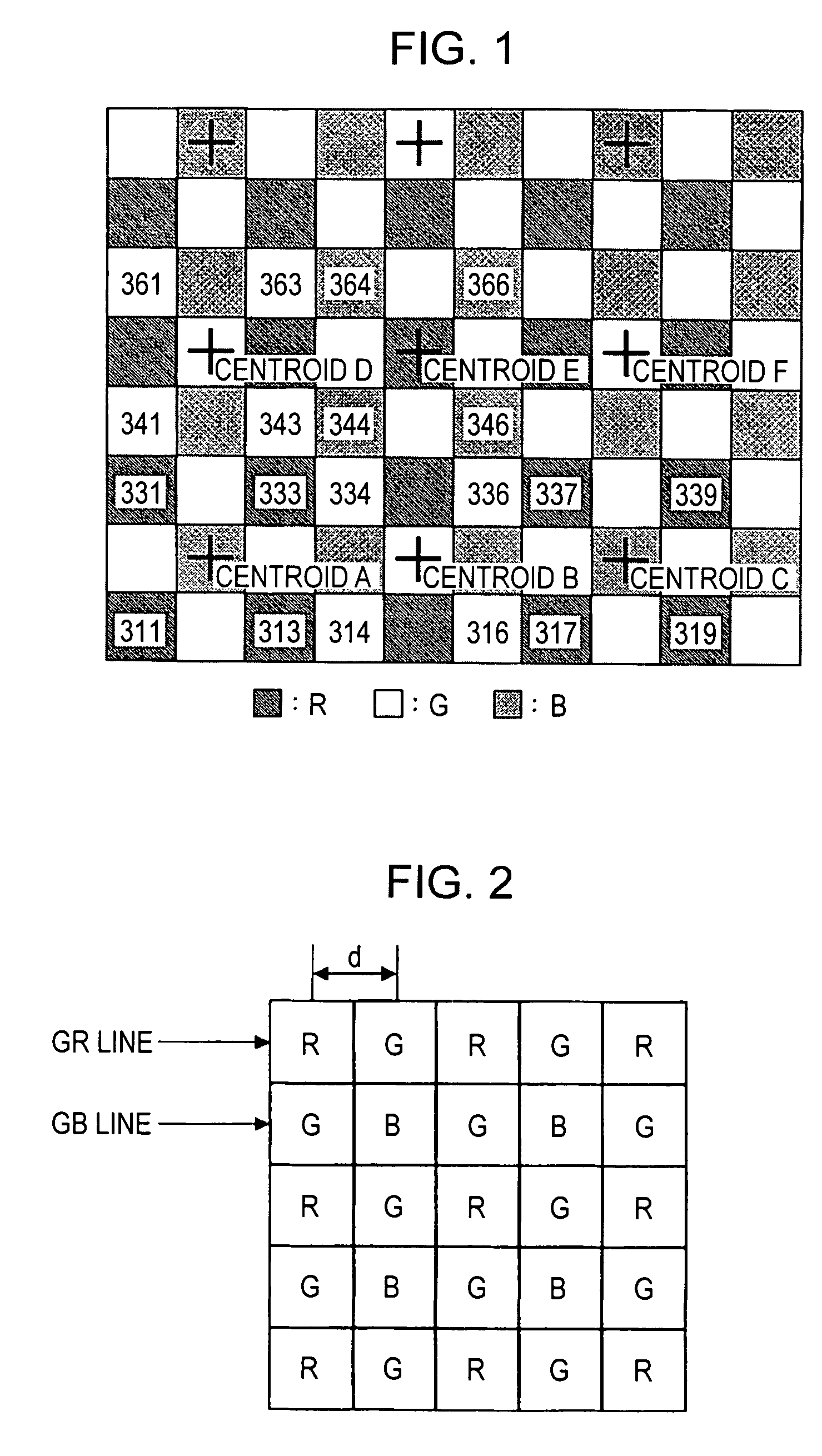Drive method for solid-state imaging device, solid-state imaging device, and imaging apparatus
a solid-state imaging and drive method technology, applied in the direction of instruments, television systems, television system scanning details, etc., can solve the problems of less flexibility, difficulty in maintaining the same color spatial repeat pattern and pitch ratio in the vertical, horizontal, oblique directions, and the color component primary component of generating luminance components, and achieve the spatial frequency characteristics of color components, which are the primary components of generating luminance components, and the effect of high-quality added signals
- Summary
- Abstract
- Description
- Claims
- Application Information
AI Technical Summary
Benefits of technology
Problems solved by technology
Method used
Image
Examples
first embodiment
[0094]FIG. 11 illustrates the concept of adding pixels by a drive method according to a first embodiment of the present invention. In the color coding of a pixel pattern shifted from the Bayer pattern by 45° in accordance with the oblique pixel pattern, from a 3×3 pixel area, the same color of pixels in the two columns and two rows are extracted and added while shifting the 3×3 pixel area by three pixels, i.e., in units of three pixels. The process of such pixel addition is specifically discussed below.
[0095] In FIG. 11, R pixels 111, 113, 151, and 153 located in the odd-numbered rows are added, and then, the resulting addition R signal is positioned at centroid A. Similarly, by horizontally shifting three pixels from the R pixels 111, 113, 151, and 153, B pixels 114, 116, 154, and 156 are added, and then, the resulting addition B signal is positioned at centroid B. By further horizontally shifting three pixels from the B pixels 114, 116, 154, and 156, R signals 117, 119, 157, and ...
second embodiment
[0098]FIG. 12 illustrates the concept of adding pixels by a drive method according to a second embodiment of the present invention. In the color coding of a pixel pattern shifted from the Bayer pattern by 45° in accordance with the oblique pixel pattern, from a 5×5 pixel area, the same color of pixels in the three columns and three rows are extracted and added while shifting the 5×5 pixel area by three pixels. The process of such pixel addition is specifically discussed below.
[0099] In FIG. 12, R pixels 211, 213, 215, 251, 253, 255, 291, 293, and 295 located in the odd-numbered rows are added, and then, the resulting addition R signal is positioned at centroid A. By horizontally shifting three pixels from the R pixels 211, 213, 215, 251, 253, 255, 291, 293, and 295, B pixels 214, 216, 218, 254, 256, 258, 294, 296, and 298 are added, and then, the resulting addition B signal is positioned at centroid B. By further horizontally shifting three pixels from the B pixels 214, 216, 218, 2...
third embodiment
[0102]FIG. 13 illustrates the concept of adding pixels by a drive method according to a third embodiment of the present invention. In the oblique pixel pattern without a color filter, from a 3×3 pixel area, adjacent pixels in the two columns and two rows are extracted and added while shifting the 3×3 pixel area by three pixels. The process of such pixel addition is specifically discussed below.
[0103] In FIG. 13, pixels 311, 312, 331, and 332 located in the odd-numbered rows are added, and then, the resulting added signal is positioned at centroid A. By horizontally shifting three pixels from the pixels 311, 312, 331, and 332, pixels 314, 315, 334, and 335 are added, and then, the resulting added signal is positioned at centroid B. By further shifting three pixels from the 314, 315, 334, and 335, pixels 317, 318, 337, and 338 are added, and the resulting added signal is positioned at centroid C.
[0104] Then, by obliquely shifting three pixels, pixels 342, 343, 362, and 363 located i...
PUM
 Login to View More
Login to View More Abstract
Description
Claims
Application Information
 Login to View More
Login to View More - R&D
- Intellectual Property
- Life Sciences
- Materials
- Tech Scout
- Unparalleled Data Quality
- Higher Quality Content
- 60% Fewer Hallucinations
Browse by: Latest US Patents, China's latest patents, Technical Efficacy Thesaurus, Application Domain, Technology Topic, Popular Technical Reports.
© 2025 PatSnap. All rights reserved.Legal|Privacy policy|Modern Slavery Act Transparency Statement|Sitemap|About US| Contact US: help@patsnap.com



